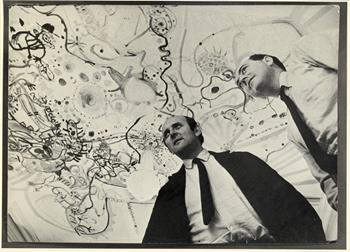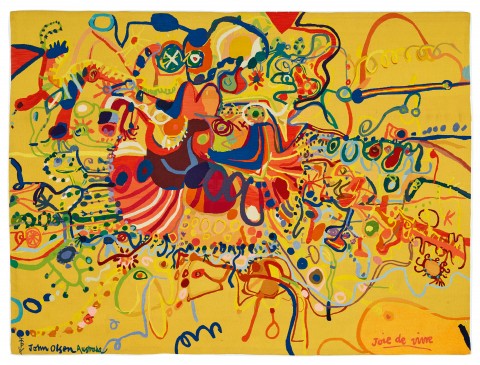JOIE DE VIVRE, 1964 - 65
JOHN OLSEN
woven wool tapestry
178.0 x 238.0 cm
signed and inscribed within woven image lower left: John Olsen Australia
bears workshop monogram lower left
inscribed with title within woven image lower right: Joie de vivre
inscribed verso: 989 – 5/6
woven at Manufactura de Tapeçarias de Portalegre, Portugal
Clune Galleries, Sydney (inscribed verso)
Joanna C. Dusseldorp, Sydney
Thence by descent
Private collection
Sotheby’s Australia, Sydney, 28 August 2006, lot 84
Private collection, Sydney
John Olsen, Clune Galleries, Sydney, April 1965, cat. 1 (another example)
The Mertz Collection of Contemporary Australian Painting, National Gallery of South Australia, Adelaide, 10 March – 11 April 1966, cat. 66 (another example)
The Australian Painters 1964 – 66: Contemporary Australian Painting from the Mertz Collection, The Corcoran Gallery of Art, Washington, 1966, cat. 22 (another example)
John Olsen Retrospective, National Gallery of Victoria, Melbourne, 1 November 1991 – 2 February 1992, Art Gallery of New South Wales, Sydney, 8 May – 28 June 1992 (another example)
The three O’s: Orban, Olsen & Ogburn, Orange Regional Gallery, Orange, 18 October – 1 December 2013, and touring (another example, illus. in exhibition catalogue)
John Olsen: The You Beaut Country, The Ian Potter Centre: NGV Australia at Federation Square, Melbourne, 16 September 2016 – 12 February 2017; Art Gallery of New South Wales, Sydney, 10 March – 12 June 2017 (another example)
Art and Australia, Ure Smith, Sydney, vol. 2, no. 3, March 1965, p. 235 (illus. another example)
Rolfe, P., ‘Olsen’s Bright Ceilings’, The Bulletin, Sydney, 1 May 1965, p. 46 (another example)
Sinclair, K., The Age, Melbourne, 16 June 1965 (another example)
Lynn, E., ‘Burst of Life’, The Bulletin, Sydney, 27 May 1967, p. 40 (another example)
Hart, D., John Olsen, Craftsman House, Sydney, 2000 (revised edition), pl. 46, pp. 77, 252 (illus. another example)
Santoro, L., and Edwards, D., John Olsen: a recipe for art, Art Gallery of New South Wales with Thames & Hudson, Sydney, 2016, p. 91 (illus. another example)
Hurlston, D., and Edwards, D., (eds.), John Olsen: The You Beaut Country, National Gallery of Victoria, Melbourne, 2016, pp. 90 (illus.), 209 (another example)
Other tapestries from the edition of six are in the collections of the National Gallery of Victoria, Melbourne, the Art Gallery of New South Wales, Sydney, and formerly the Harold E. Mertz Collection, United States of America
OLSEN.jpg

the you beaut country), 1962
During the early 1960s, Olsen extended his creative interests to embrace painting ceilings in the homes of his friends and the designing of tapestries, each influenced and enriched the other. In 1962, art dealer Frank McDonald commissioned Olsen to paint a ceiling in his Woollahra home - a sunburst chiefly of primary colours, drawn spontaneously by brush directly onto the ceiling. The result was Summer in the You Beaut Country, imbued with his typically inquisitive, wandering lines, lively arabesques, and grinning faces. (The painting on six panels is now in the collection of the National Gallery of Victoria, Melbourne.) Joie de Vivre, 1964 Olsen's first tapestry design, followed shortly after. Although it was not sent to Portugal's Manufactura de Tapeçarias de Portalegre until 1964, the same enthusiasm translated into sunny colours, line and form inspires both. The differences are principally those of medium derived from technical requirements, the nature of wool and its use in tapestry requiring a greater degree of definition. Furthermore, the texture and warmth of the material gave it a different visual effect, colour texture and temperature adding to its celebratory mood. Joie de Vivre was catalogue number one in Olsen's solo exhibition at Sydney's Clune Galleries in 1965. The vitality of his work was infectious, reflected in the critical acclaim it received. Wallace Thornton wrote in the Sydney Morning Herald that it was 'the most joyful exhibition to be seen in Sydney in recent memory.'1 In his guise as critic, artist James Gleeson's enthusiasm matched that of Olsen - 'whose work glows and blooms with an uninhibited acceptance of life.'2 Woven in an edition of six, Joie de Vivre tapestries were acquired by the Art Gallery of New South Wales, Sydney, and the National Gallery of Victoria, Melbourne while another went abroad to the USA as part of the Harold Mertz Collection.
Later, a visit to the Portalegre workshop soon resulted in more tapestries - Nude with Clock, Yellow Summer, and Verdure (Westpac Banking Corporation), all of 1966. Now more inclined towards the monumental, they were suited to the public places for which they were destined. Tapestry designs continued into the early seventies, Olsen working with the Queensland weavers Bruce Arthur and Deanna Conti, while the following decade found Olsen at the Victorian Tapestry Workshop, Melbourne. Of these Paella 1981 was acquired by Smorgon Consolidated Industries, Victoria; Rising Sun was woven in 1987; and Light Playing with Evolution 1989 went to The University of Melbourne. The predominance of yellow in each celebrated the sun-drenched source of life. Of all these wonderful tapestries, Joie de Vivre is the most spontaneous in style, its colours and design exuberantly expressing the joyous vivacity of its title. Cheeky images of clown-like fun, its focal point the mad mouthed blue lips and jack-in-the-box, boisterously sport across a lively field of colour. His sensually pulsating rhythms and sinuous calligraphic lines lead 'the eye a wanton kind of chase'.3 Yet, for all its robustness, Joie de Vivre has a distinctive refinement and an elegance that is beguiling and idiosyncratic.
1. Thornton, W., 'Sculpture, Two One-man shows', Sydney Morning Herald, 21 April 1965, p. 15
2. Gleeson, J., 'Artist glad of life', The Sun-Herald, Sydney, 25 April 1965, p. 76
3. Hogarth, W., The Analysis of Beauty, quoted in Burke, Joseph, William Hogarth, The Analysis of Beauty, Oxford University Press, 1955, p. 42
DAVID THOMAS
